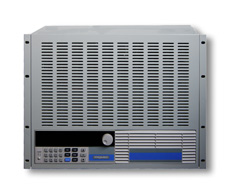Constant current - CC
Regardless of the input voltage, the current sink draws the set current.
Option charge and deep discharge protection
To protect the unit under test, the charge and deep discharge protection can be set as a safety option: The current is only drawn from the DUT when the switch-on voltage is reached, or the load switches off the input after reaching a maximum voltage.
Soft current rise option
Furthermore, a soft current rise can be set for the protection of the DUT: After the adjustable time has elapsed, the current sink automatically switches to CC operating mode.
Constant current at constant voltage - CC + CV
In the CC operating mode, the programmable electronic load can be set directly to the new operating mode by entering a value for the voltage.
Constant resistance - CR
In this operating mode, the current sink behaves like a fixed resistor. A charge and deep discharge protection for the device under test (DUT) can also be set here.
Constant resistance at constant voltage option - CR+CV
When the voltage reaches the set value, the voltage and resistance are held by the current sink, regardless of the voltage input.
Constant voltage - CV
At the set voltage the load draws the maximum current. With the PEL97 series, a soft start of the voltage can also be set in this operating mode, according to the set time, the voltage then increases slowly.
Constant power - CW
The electronic load consumes a constant power. If the input voltage increases, the current flow decreases accordingly. If the input voltage is too low, the current limitation becomes active. Again, additional charge and deep discharge protection can be set for the DUT.
Dynamic operation - Transient operation
In dynamic operation, the electronic load can be switched between two levels to determine the specific behavior of the DUT. The operation can be performed continuously, pulsed or triggered.
The width of Level A and B can be adjusted, as well as the current rise and fall (Rising and Falling, respectively).
Short-circuit function
In this operating mode, the maximum current is taken from the DUT. The process can be started from any operating mode and depends on the set value.
The current can be limited in the system settings.
Battery test
The charge delivered by the battery is calculated and displayed as a discharge curve. Current and time are adjustable, as well as a definable residual voltage at the battery. Various evaluation and documentation options are available.
Automatic list function
In addition to manual front operation, the electronic load can also be conveniently controlled via software. RS232, RS485 and USB are available as interfaces, optionally also GPIB and CAN.
Optionally, an automatic test with list function can be set on the front panel. Eight different programs (infinite via PC) with 200 test steps each are available on the front panel.
The values for current and time can be set individually.
Advanced automatic function test
In this operating mode, fully automated function tests can be performed. There are 50 test steps available in eight different programs (infinite on the PC).
At each test step the operating mode (CC, CV, CR, CW, load off, short circuit) can be set with the respective desired values.
More features:
• Test start via interface or trigger-in signal
• Step function for single tests
• Test stop at FAIL
• PASS/FAIL evaluation based on limit values (min/max evaluation)
• Result evaluation can be saved in database
• Output of data to Excel, printout also possible
• Evaluation via signal at trigger output
• and much more...
















